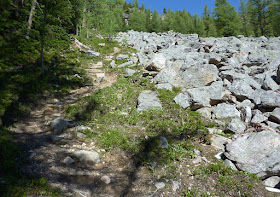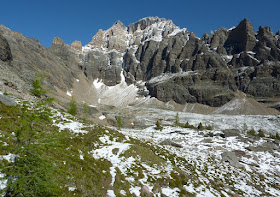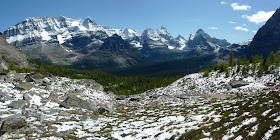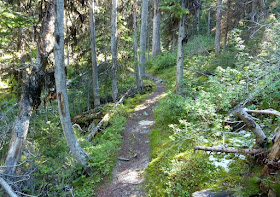But it does. The route is often clear ...
... but there are sometimes rocky parts where you must choose the best option for your length of leg, size of boot, sense of balance, etc. Keep an eye out for the alpine blazes so you don't get fooled by a false path in these locations.
As you proceed on the Huber Ledges a chain of lakes comes into view. In this next picture note the gray field of boulders towards which the trail is heading; this is another spot where the alpine blazes are important. It's also the only place on the Huber Ledges where you can improvise a relief stop.
Oesa is at top left. Then the water flows through Lefroy Lake and Lake Victoria; the shallow green water at far right, directly under the Yukness Ledges, is one of the Nymph Pools.
I took a closer, wider photo of Lake Oesa as we exited the boulder field. The relatively flat, stony shelf at right is a popular picnic stop, whether you arrive via the Huber Ledges, Yukness Ledges, or the Oesa trail that arrives directly from Lake O'Hara.
In the photo the lake doesn't look as large as it should. For scale, can you find the people enjoying the picnic grounds on the right? This next picture will zoom and point them out. If necessary, click to enlarge!
Joan and I enjoyed a sunny lunch with at least a dozen other hikers scattered around the shelf. Then we rambled to the far side to join the Yukness Ledges trail, which drops off the Oesa platform before it reaches the Yukness scree slope. Here, we look back to see other hikers making that descent. It's minor, but it requires a couple of alpine blazes to find the correct way.
The initial scree path has chunks of rock bigger than stones but smaller than boulders.
The trail soon arrives at a tilted and fracturing table-top. Weaving between the blocks, the alpine route reaches the edge of the highest level, and drops down, precipitously at first, and then more easily, to the lowest level. This picture was taken from our earlier viewpoint on the Huber Ledges. If you click to enlarge you can discern the trail hugging the far right of the ledge.
Here we look back towards Oesa from the table-top.
Other hikers pose for a photo near the edge.
This blaze marks the start of the clamber down to the lower levels of Yukness -- not the end of the road, which it otherwise resembles.
Once headed west the trail quickly enters a geological grove, shards fallen down from North Yukness Peak. Fortunately for us they don't break loose often, at least on a human time scale.
There is just enough climbing and descending to keep the hiker warmed up.
There are wonderful views from Yukness Ledges, many of which are variations on a theme. I'll present only one example, which looks straight along the length of Lake O'Hara. The zig-zag trail climbing from the lakeside, far right, is the direct route to Oesa from O'Hara. There are pale green rings of submerged avalanche debris next to the shore.
Eventually the route bends south as its works around the promontory, and now it is carrying us into the Opabin Plateau, but higher up than the east trail, visible between the trees below on the right.
The Yukness Ledges route ends at Hungabee Lake, where we were in the snow two days ago. But first there is another boulder field to thread through.
Then it's down the east trail one more time to Lake O'Hara. After we return to the cabin and clean up, we head to the cheerful-looking lodge for dinner.
Sadly, the next morning we must depart. We have a full day of driving to begin the last segment of our trip, and a completely opposite one to what we have accomplished so far. We're changing from the mountains to the plains, and from chills to dry heat. We're heading to Brooks, about 230 miles to the east, where we'll stay while visiting Dinosaur Provincial Park. But that's a subject for the next post.
Here is a farewell photo of Lake O'Hara and Cathedral Mountain, taken while waiting for the morning bus.
As soon as you leave O'Hara, you're planning how and when to return.


























































